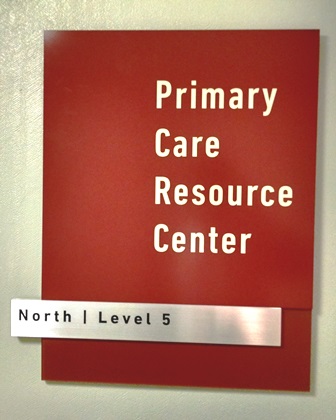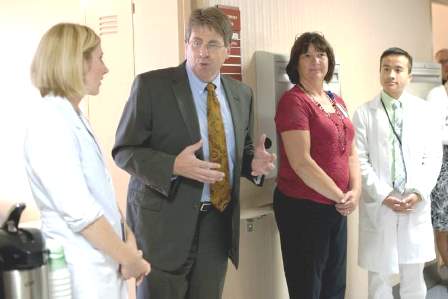This interview was compiled by Kristen Willard, M.S.
Thank you for sharing your experiences with the PRAXIS Nexus community. Let’s start with just a little bit of background on your organization.
The Pittsburgh Regional Health Initiative (PRHI) is a regional health improvement collaborative serving western Pennsylvania (https://www.prhi.org/). Under the umbrella of the Jewish Healthcare Foundation, PRHI develops and manages programs, research and training to improve the quality, efficiency and cost of patient care.
We are familiar with the great work you do with individuals with COPD. Can you tell our readers a bit more about your efforts in this area?

PRHI has been working on COPD since about 2009, beginning with epidemiological research on COPD utilization and readmissions. COPD is a huge problem in western PA, with a COPD hospitalization rate 24% higher than the rest of the country (in data from the Pennsylvania Health Care Cost Containment Council). We explored the role of the nurse care manager in reducing readmissions, and ran successful pilot programs at two community hospitals. We pulled together our learnings from these pilots to publish a useful COPD readmission reduction guide, used all over the country.
In 2012, we launched a successful Primary Care Resource Center (PCRC) prototype at Monongahela Valley Hospital (MVH). The PCRC is a hospital-based support hub, staffed by nurse care managers, a pharmacist and an administrative assistant with full access to their institution’s array of specialty services. Initially targeting only patients with COPD, the MVH prototype PCRC demonstrated the impact of careful coordination of care – from patient admission, through discharge and into the care of community primary care physicians. The PCRC model is explicitly designed to enable small and medium-sized primary care physicians the opportunity to offer their patients enhanced disease management education and post-discharge support.
Although enormously successful, the PCRC prototype revealed a flaw in the “COPD-only” approach to care management: the importance of comorbidities. The PRHI research team noted that 50% of COPD patients carried ICD-9 codes for heart failure and coronary disease, and in practice the care management pathways kept colliding. PRHI then went back to the drawing board and redesigned the PCRCs around three diseases: COPD, heart failure, and acute myocardial infarction.
The opportunity to scale this model came in July 2012, when PRHI received a $10.4 million Health Care Innovation Award from the Center for Medicare & Medicaid Innovation. Six community hospitals in western Pennsylvania and northern West Virginia were recruited to build PCRCs within their hospitals, and in support of their more than 300 primary care physicians. The participating hospitals were: Butler Health System, Conemaugh Memorial Medical Center, Indiana Regional Medical Center, Sharon Regional Medical Center, Uniontown Hospital and Wheeling Hospital.
The goal of the project was to sharply reduce 30-day all-cause readmission rates for the three target conditions. Long term, the aspiration was to longitudinally co-manage patients under the direction of the primary care practices, with the intent of optimizing healthy behaviors as well as preventing hospitalization.
To enable their work, every PCRC team member received hundreds of hours of PRHI training and coaching in care coordination, advanced disease management, quality improvement, and motivational interviewing. A standardized Care Management Framework was collaboratively developed in a series of meetings with all stakeholders, and disseminated across the project. Moreover, PCRC staff participated in live and virtual Knowledge Networks, facilitated by PRHI and national experts, to keep their skills sharp.
The PCRC concept was designed by Keith T. Kanel, MD, the Chief Medical Officer of Pittsburgh Regional Health Initiative. He is Clinical Associate Professor of Medicine at the University of Pittsburgh School of Medicine, and a practicing internal medicine specialist. Dr. Kanel is a frequent collaborator with the COPD Foundation, dating back to the early CONCERT workshops of 2010.

Has your institution had success in lowering its COPD readmission rates as a result of the programs you described?
Between July 2013 and October 2015, the PCRCs managed 14,279 hospital discharges of 8,947 unique patients with COPD, HF, or AMI. They logged 40,541 face-to-face contacts with hospitalized patients for care management, education, medication reconciliation, self-management skill building and advance directive planning, performed 28,066 telephone calls to (or on behalf of) patients and conducted 2,333 outpatient visits to patients’ homes or post-acute facilities. All cause, 30-day readmissions for all three conditions fell from 20.4% in the first quarter of the project, to 15.3% in the final quarter of the project exactly two years later – for an overall decline of 25.0%. Readmission rates for patients with COPD fell from 23% to 18.3%, a decline of 20.4%.
The Monongahela Valley PCRC prototype has had comparable readmission reduction and is attracting national attention for its work. In August 2014, MVH became the 7th hospital in the country to receive Advanced Disease-Specific Certification in COPD by the Joint Commission. The accreditation requires a range of training and programmatic features – all of which were built into the PCRC’s COPD care. In the years 2015-2017, the hospital received a 5-star rating from Healthgrades for COPD care, with recognition in 2015 of an 80% decline in COPD mortality among Medicare beneficiaries.
Thank you so much. In the course of all of these intensive efforts, what lessons did your teams learn that you might share?
Perhaps the most important lesson of the project was the power of unleashing experienced nurses, pharmacists, respiratory therapists and physicians to freely innovate. By carving out protected time to problem-solve, meaningfully engage their patients in new ways and break down barriers, readmission rates sharply declined.
We believe in sharing our findings so that we all learn. We proudly presented our work at COPD8usa, COPD9usa, and both COPD Foundation Readmission Summits.
As of this posting, we are just processing the PCRCs’ final data submission and will share what we learn.
We look forward to seeing what’s next! What elements of the approaches you described do you think have made you most successful?
The training and coaching offered to PCRC staff equipped them to support patients in highly effective ways. Among the most innovative of our offerings was a COPD Focused Factory. Developed by Harvard business professor Wickham Skinner, Focused Factories are special collaborative efforts to support targeted quality improvement. Among its most important features was training to help patients with COPD to more effectively use their inhalers in an innovative self-management curriculum. This past year, all of the sites were trained in outpatient spirometry and given protocols to begin case finding. Both experiences were co-designed with Dr. Brian W. Carlin, Chairman of the National Lung Health Education Program.
What do you find about working in COPD care most challenging?
Because so many patients with COPD also are lifelong cigarette smokers, staff approaches to patient disease management education must confront the enormous challenge of addiction. The tools PCRC staff picked up from PRHI training on motivational interviewing became essential in increasing the likelihood of successful interactions with their COPD patients.
Now for the flip side of the question; what do you find about working in COPD care most rewarding?

In end-of-project interviews with care managers and pharmacists, the reward of having real time with patients was cited again and again as the most important feature of the PCRC. Time translated into relationships that revealed new opportunities to support patients and their families, time to find – and correct – a medication error, and time to offer real patient education and then confirm that the patient is comfortable with self-care once at home and away from the stressful hospital experience.
For example, the staff extensively used motivational interviewing (MI) techniques in their patient interactions. MI is a collaborative conversation style that allows patients to discover their own reasons for making healthy lifestyle changes. Recalling one of her patients with COPD, a PCRC nurse care manager related the following story: “When we learned that the patient was also a recovering alcoholic, we understood that she was able to stop drinking years ago. Making a link between her ability to quit drinking might give her confidence in her ability to quit smoking now. So we asked her, ‘How important, on a scale from 0 to 10, was it for you to stop drinking?’ When she answered ‘11,’ we knew progress was possible. She was smoking a pack and a half a day then; she’s down to three cigarettes a day now.”
This is inspiring work and we are so happy you are open to sharing your efforts with us. Any closing notes?
External funding of the PCRCs ended on October 31, 2015. In a reflection of the value they place on the PCRC model, and the PRHI-trained staff who care for complex patients, five of the partner hospitals have decided to adopt their PCRCs as part of normal hospital operations into the future.
Our thanks to the PCRC team at PHRI for sharing their work and lessons learned with us – and for all they do for individuals with COPD. Please share your comments and questions below!
This page was reviewed on March 5, 2020 by the COPD Foundation Content Review and Evaluation Committee